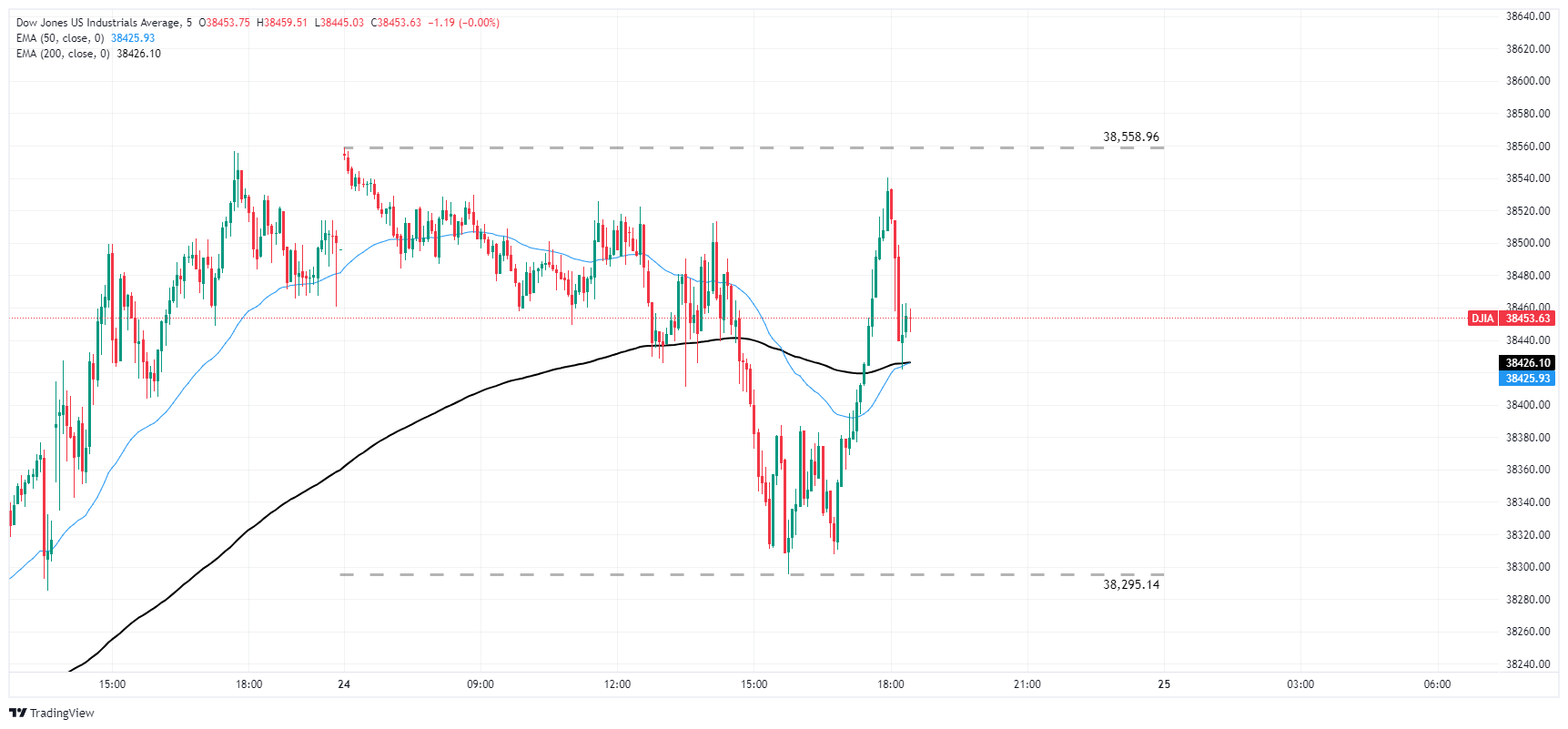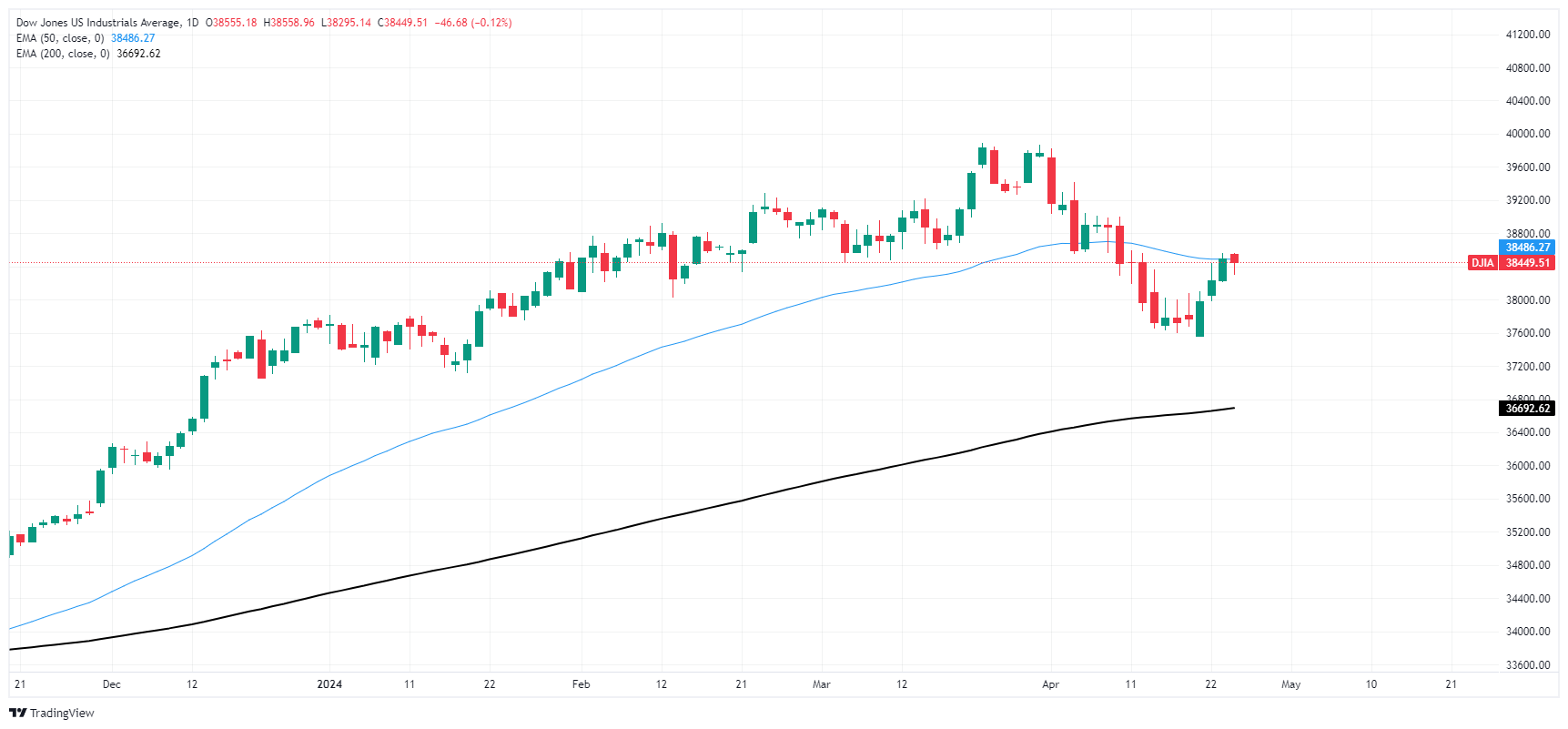- Dow Jones falls below 38,400, then recovers as risk appetite falters.
- Durable goods orders in the US missed forecasts but still rose.
- US GDP and inflation measured by the PCE index are the key data for the rest of the week.
The Dow Jones Industrial Average (DJIA) faltered on Wednesday, falling from recent highs near 38,550.00, as investors eased off Tuesday's risk appetite. The index rallied late in the US session as US data continues to irritate financial markets, which remain overwhelmingly focused on US Federal Reserve rate cuts.
In March, US durable goods orders missed forecasts, as non-defense durable goods orders rose 2.3%, versus the expected 2.5%, and non-transportation durable goods orders rose just 0.2%, compared to the 0.3% expected. Despite not meeting forecasts, both figures were well above previous figures (revised 1.5% from 2.2% and revised 0.1% from 0.5%, respectively). Durable goods orders rose 2.6% month-on-month versus 0.7% the previous month (revised from 1.4%).
The rebound in US activity dashes market hopes for an acceleration of rate cuts, which were revived on Tuesday after US Purchasing Managers' Index (PMI) figures .did not meet expectations. Markets will now focus on Thursday's US Gross Domestic Product (GDP) and Friday's Personal Consumption Expenditure (PCE) inflation. US GDP is expected to decline to 2.5% annualized in the first quarter, down from 3.4% previously, while core US personal consumption price index (PCE) inflation is expected to remain stable at 0.3% monthly in March.
Dow Jones News
The Dow Jones is recovering from the fall suffered in the early stages of the US session, which made it briefly fall below 38,300 points. The main stock indices are now close to 38,500 points. Earnings season is in full swing, with Meta Platforms (META), IBM (IBM), and Chipotle (CMG) reporting earnings after the market close on Wednesday. Corporate earnings are helping to bolster stock valuations, but hopes of lower interest rates continue to weigh on investors' prospects, holding back recent gains.
About half of the individual stocks that make up the Dow Jones are currently in the red for Wednesday, with loss leaders including Boeing Co. (BA) and Home Depot Inc. (HD), losing 2.75% and 1.76%. , respectively, at the time of writing. The most bullish stocks on the DJIA are Coca-Cola Co. (KO) and Intel Corp. (INTC), each up about 1.3% on the day.
Dow Jones Technical Outlook
The Dow Jones set an early high for Wednesday at 38,558.96, with the day's low recorded at 38,925.14. Overall momentum continues to lean upward. The overall trend remains bullish, and the index is up 2.35% from last session's low near 37,500.00 points.
The Dow Jones is about to snap a three-day winning streak, as the main index struggles on the mildly bearish side. The DJIA remains stuck in a difficult intermediate zone between the latest session high near 40,000.00 and the 200-day EMA, which offers important technical support from 36,720.70.
Dow Jones five minute chart
Dow Jones Daily Chart
Frequently Asked Questions About the Dow Jones
What is the Dow Jones?
The Dow Jones Industrial Average, one of the world's oldest stock indices, is made up of the 30 most traded securities in the United States. The index is weighted by price rather than capitalization. It is calculated by adding the prices of the securities that comprise it and dividing them by a factor, currently 0.152. The index was founded by Charles Dow, also founder of the Wall Street Journal. In recent years it has been criticized for not being sufficiently representative, since it only follows 30 companies, unlike broader indices such as the S& P 500.
What factors influence the Dow Jones index?
There are many factors that drive the Dow Jones Industrial Average (DJIA). The main one is the aggregate performance of its component companies, revealed in quarterly corporate earnings reports. US and global macroeconomic data also contribute, influencing investor sentiment. The level of interest rates, set by the Federal Reserve (Fed), also influences the DJIA, as it affects the cost of credit, on which many companies largely depend. Therefore, inflation can be a determining factor, as well as other parameters that influence the decisions of the Federal Reserve.
What is the Dow theory?
The Dow Theory is a method for identifying the main trend of the stock market developed by Charles Dow. A key step is to compare the direction of the Dow Jones Industrial Average (DJIA) and the Dow Jones Transportation Average (DJTA) and only follow trends where they are both moving in the same direction. Volume is a confirmation criterion. The theory uses elements of maximum and minimum analysis. The Dow theory proposes three phases of the trend: accumulation, when the smart money begins to buy or sell; public participation, when the general public joins the trend; and distribution, when the smart money abandons the trend.
How can I trade with the DJIA?
There are several ways to trade the DJIA. One of them is to use ETFs that allow investors to trade the DJIA as a single security, instead of having to buy shares of the 30 companies that comprise it. A prominent example is the SPDR Dow Jones Industrial Average ETF (DIA). Futures contracts on the DJIA allow traders to speculate on the future value of the index, and options provide the right, but not the obligation, to buy or sell the index at a predetermined price in the future. Mutual funds allow investors to purchase a portion of a diversified portfolio of DJIA securities, providing exposure to the global index.
Source: Fx Street
I am Joshua Winder, a senior-level journalist and editor at World Stock Market. I specialize in covering news related to the stock market and economic trends. With more than 8 years of experience in this field, I have become an expert in financial reporting.






![News and prognosis of the price of the pound sterling: the GBP/USD earns even when the unemployment rate in the United Kingdom is accelerated [Video] News and prognosis of the price of the pound sterling: the GBP/USD earns even when the unemployment rate in the United Kingdom is accelerated [Video]](https://editorial.fxsstatic.com/images/i/gbp-usd-001_Large.jpg)
